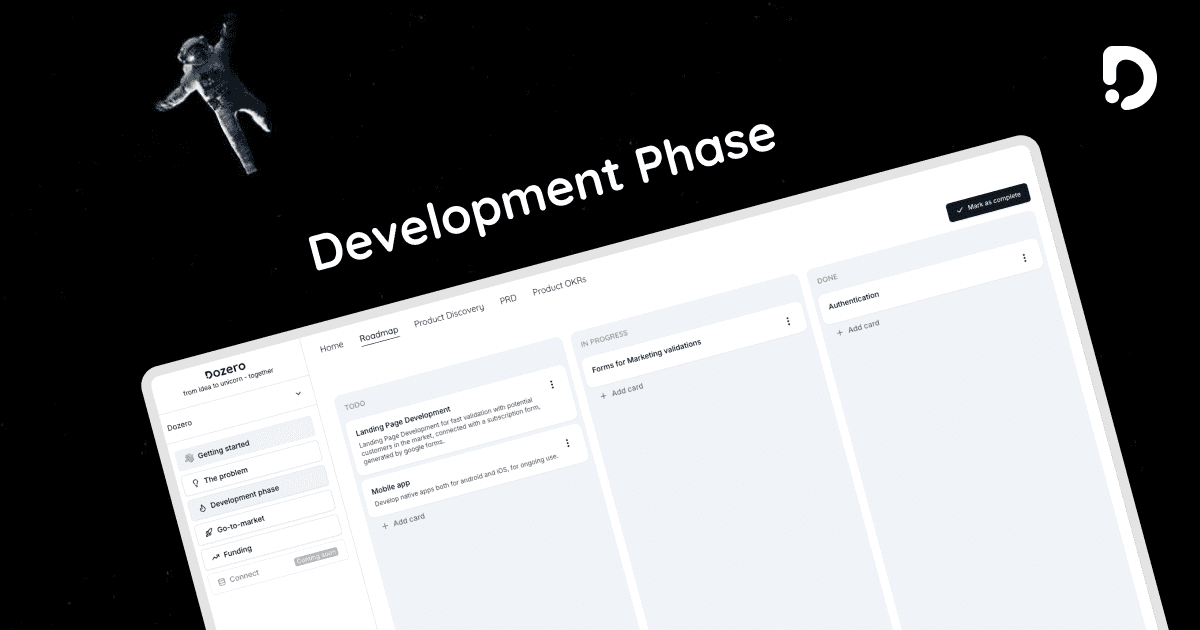< Voltar
Development Phase
Product Requirements Document (PRD)
6 de nov. de 2024
A complete Product Requirements Document (PRD) is a comprehensive document that outlines the essential aspects of a product or feature, serving as a guide for the product development team throughout the Discovery and Delivery phases. It typically includes:
Problem Space: Clearly defines the problem or opportunity the product aims to address, providing context and justification for its development.
Solution: Describes the proposed solution or feature, detailing how it will solve the identified problem or capitalize on the opportunity.
User Stories: Provides specific scenarios from the user's perspective, illustrating how they will interact with the product and what they aim to achieve.
Goals and Metrics: Outlines the key objectives for the product, including measurable success criteria and potential indicators of failure.
User Segments: Identifies the primary user groups for whom the product is being developed.
A complete PRD ensures that all stakeholders have a shared understanding of the product's purpose, scope, and expected outcomes, facilitating effective collaboration and decision-making throughout the product development process.
Netflix example
Netflix: Personalized Content Recommendation System
Problem Space: Users often feel overwhelmed by the vast amount of content available and struggle to find shows or movies that match their interests, leading to decision fatigue and reduced engagement.
Solution: Develop an AI-driven recommendation system that personalizes content suggestions based on user viewing history, preferences, and behavior patterns.
User Stories:
As a user, I want to receive personalized movie and show recommendations so that I can easily find content that interests me.
As a user, I want to see a "Because You Watched" section that suggests similar content to what I've previously enjoyed.
Goals and Metrics:
Increase user engagement by 15% through personalized recommendations.
Reduce the time users spend searching for content by 20%.
User Segments:
Existing subscribers who frequently watch content.
New users exploring the platform for the first time.
Shopify example
Shopify: Enhanced Analytics Dashboard
Problem Space: Merchants on Shopify lack comprehensive insights into their store performance, making it difficult to make data-driven decisions to optimize sales and marketing strategies.
Solution: Create an enhanced analytics dashboard that provides detailed reports on sales trends, customer behavior, and marketing campaign effectiveness.
User Stories:
As a merchant, I want to view detailed sales reports so that I can understand my store's performance over time.
As a merchant, I want to track customer behavior to identify popular products and optimize inventory.
Goals and Metrics:
Improve merchant satisfaction with analytics tools by 25%.
Increase the number of merchants using analytics features by 30%.
User Segments:
Small to medium-sized business owners using Shopify.
Marketing teams looking to optimize their campaigns.
Spotify example
Spotify: Collaborative Playlist Feature
Problem Space: Users want to share and collaborate on playlists with friends, but current options are limited and not user-friendly, reducing social engagement on the platform.
Solution: Introduce a collaborative playlist feature that allows multiple users to add, remove, and reorder songs in a shared playlist seamlessly.
User Stories:
As a user, I want to create a playlist with my friends so that we can all contribute our favorite songs.
As a user, I want to see who added each song to the playlist to know my friends' music preferences.
Goals and Metrics:
Increase social interactions on the platform by 20%.
Boost the number of collaborative playlists created by 50%.
User Segments:
Users who frequently share music with friends.
Groups planning events or parties who want a shared playlist.

